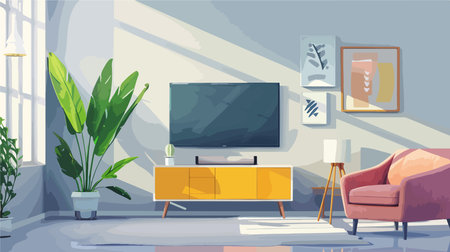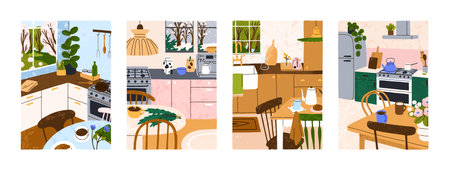1. Understanding the Essence of British Interior Design
British interior design is a tapestry woven from centuries of history, regional traditions, and a subtle yet unmistakable sense of national identity. At its core, this design philosophy is not just about aesthetics—it’s about storytelling, comfort, and a reverence for both heritage and innovation. From the grandeur of Georgian stately homes with their ornate cornicing and rich mahogany finishes, to the eclectic charm of Victorian terraces brimming with collected curiosities, British interiors have always mirrored the nation’s evolving social landscape. Even in today’s contemporary city flats, there remains a distinctively British approach: a harmonious blend of old and new, where antique finds sit comfortably alongside modern art or designer lighting.
What truly sets British interiors apart is their sense of lived-in elegance. Spaces are designed to be inviting rather than intimidating, layered with textures—think wool throws, velvet cushions, and timeworn leather armchairs—that beckon you to settle in. Colours are often inspired by Britain’s natural landscapes: muted greens reminiscent of rolling hills, deep blues evoking stormy skies, or warm terracottas echoing brick facades. Above all, British interior design values character over perfection; a slightly battered bookcase or a mismatched china set tells a story and adds personality.
This uniquely British sensibility has been shaped by waves of historical influence—from medieval manor houses to post-war council flats—and continues to evolve as designers reinterpret tradition for modern living. Whether you’re drawn to classic country style or sleek urban minimalism, understanding these cultural roots will help you choose an aesthetic that feels authentically British and perfectly at home.
Classic British Styles: Georgian, Victorian, and Edwardian
Britain’s rich design heritage is rooted in its classic interior styles—Georgian, Victorian, and Edwardian. Each era brings its own distinct character, yet all three remain cherished blueprints for those seeking timeless sophistication with a uniquely British flair. Understanding their key elements, colour palettes, and features will help you seamlessly blend tradition into contemporary living.
Georgian Elegance
The Georgian style (1714–1837) celebrates symmetry, proportion, and understated luxury. Drawing inspiration from Palladian architecture, interiors feature grand yet balanced spaces. Walls are typically adorned with decorative mouldings and panelled wainscoting. Fireplaces serve as focal points, often crafted from marble or stone.
| Key Elements | Colour Palette | Distinctive Features |
|---|---|---|
| Sash windows, ornate cornices, symmetrical layouts | Dove grey, muted greens, powder blue, soft cream | Elegant chandeliers, antique mirrors, refined furniture silhouettes |
Incorporating Georgian Style Today
Introduce Georgian poise into modern homes by choosing classic wall colours and incorporating period-inspired furniture or cornicing. Balance symmetry with contemporary simplicity for a fresh take on this enduring look.
Victorian Drama
The Victorian era (1837–1901) is synonymous with opulence and eclectic detail. Interiors from this time are layered with patterns—think damask wallpapers and richly textured fabrics. Dark wood furniture and elaborate fireplaces anchor the space, while decorative tiles and stained glass add visual intrigue.
| Key Elements | Colour Palette | Distinctive Features |
|---|---|---|
| Heavy drapery, carved woodwork, patterned floors and walls | Burgundy, forest green, navy blue, deep golds | Tasselled lampshades, intricate rugs, display cabinets filled with curiosities |
Modernising Victorian Style
To avoid overwhelming smaller or open-plan spaces, use bold Victorian patterns as accent walls or in soft furnishings. Pair statement antiques with streamlined contemporary pieces for an updated twist on maximalist grandeur.
Edwardian Lightness
The Edwardian period (1901–1910) marks a shift towards lighter interiors and greater comfort. Rooms are airier with higher ceilings and more natural light. Soft pastels replace darker hues; floral motifs and simple wood panelling echo a move towards informality and the beginnings of modern suburban living.
| Key Elements | Colour Palette | Distinctive Features |
|---|---|---|
| Crittall-style windows, light wood floors, bay windows, built-in window seats | Pale blues, sage green, gentle pinks, crisp white | Stained glass details, Art Nouveau influences, woven wicker or cane furniture |
Bringing Edwardian Ease Home
Create an inviting Edwardian-inspired space by layering airy textiles and subtle floral prints. Mix traditional joinery with clean-lined furniture to bridge old-world charm with present-day ease.

3. The Appeal of Country Cottage and English Rustic
If your vision of British interior design conjures up images of rolling green hills, quaint villages, and sun-dappled kitchens, then the country cottage and English rustic styles may be your perfect match. These aesthetics are deeply rooted in Britain’s rural heritage and evoke a sense of nostalgia and comfort that is both inviting and effortlessly timeless.
Natural Materials: The Heart of the Home
At the core of this style lies a celebration of natural materials. Expect to see exposed wooden beams, stone or terracotta flooring, and furniture crafted from solid oak or pine. These elements create an authentic connection to the countryside, bringing a tactile warmth into your living spaces. Worn finishes, rather than polished perfection, are embraced—each dent or scratch tells its own story and adds character to the home.
Floral Patterns and Cosy Textiles
No country cottage would be complete without a generous use of florals and soft furnishings. Think faded chintz curtains, scatter cushions in ditsy prints, and hand-embroidered linens. Layering different fabrics—cotton, wool, linen—adds depth and comfort while keeping things relaxed and inviting. This approach makes it easy to mix old with new, or to incorporate cherished family heirlooms into your décor.
The Lived-In Warmth of Rural Living
Perhaps most importantly, English rustic interiors celebrate the idea that homes are for living in. Rooms feel gently curated rather than meticulously styled; you might find stacks of well-thumbed books on a windowsill or fresh wildflowers arranged in a mismatched jug. Practicality reigns supreme—think boot racks by the door, open shelving for crockery, and baskets for firewood—all nodding to everyday life in the countryside.
The true appeal of the country cottage style is its ability to create sanctuary—a space where imperfection is not just accepted but cherished. In choosing this aesthetic, you’re not only embracing traditional British design elements but also inviting in a way of life that values comfort, warmth, and authenticity above all else.
4. Modern British Trends: Eclecticism and Urban Influence
Contemporary British interior design is renowned for its ability to seamlessly marry heritage with innovation, producing spaces that feel both rooted and refreshingly forward-thinking. Nowhere is this more evident than in the urban heart of London, where traditional architectural details often meet bold, experimental accents. This modern approach favours an eclectic mix—juxtaposing vintage finds with cutting-edge pieces—to create homes brimming with personality and character.
The Art of Blending Old and New
British interiors today rarely subscribe to a single period or style. Instead, they thrive on contrast: think ornate Victorian fireplaces set against clean-lined Scandinavian sofas, or Georgian cornices paired with abstract art. This interplay between old and new not only preserves the nation’s design legacy but also allows for a fresh interpretation suited to contemporary lifestyles.
| Traditional Element | Modern Counterpart | Effect |
|---|---|---|
| Wooden Floorboards | Industrial Concrete Accents | Warmth meets urban edge |
| Chesterfield Sofa | Bold Geometric Rug | Classic comfort with playful energy |
| Crown Moulding | Minimalist Lighting | Elegant backdrop with modern highlights |
London Chic: Urban Sophistication Defined
The capital’s influence is unmistakable in the rise of “London chic”—a style marked by sleek lines, dramatic contrasts, and a cosmopolitan flair. Here, you’ll find dark feature walls offset by metallic fixtures, oversized artwork layered over exposed brick, and plush textiles that soften industrial frameworks. The result is an atmosphere that feels at once luxurious and lived-in—perfect for city dwellers seeking both comfort and impact.
Eclectic Touches: Curated Individuality
No two modern British homes are alike; each serves as a curated reflection of its inhabitants’ journeys and tastes. Eclecticism reigns supreme, encouraging the display of travel mementos, upcycled furniture, and artisan crafts alongside high-street staples. Pattern clashes—floral with stripes, tartan with velvet—are celebrated rather than shunned, creating visually dynamic yet harmonious interiors.
Recent Innovations in British Design
The evolution of British interiors owes much to sustainability trends and technological advancements. Designers now favour eco-friendly materials like reclaimed wood or recycled glass, while smart home features discreetly enhance convenience without compromising aesthetics. Whether it’s integrating biophilic elements or experimenting with modular furnishings, these innovations continue to push boundaries—ensuring that British style remains globally influential yet distinctly local.
5. Choosing the Right Style for Your Home
Selecting a British interior design style is more than simply following trends; it’s about crafting a living space that reflects your individuality, lifestyle, and the unique character of your home. The British approach to interiors is famously eclectic—rooted in history, yet unafraid to blend the old with the new. Here’s how to make informed choices that feel both authentic and practical.
Consider Your Architectural Backdrop
Start by assessing your home’s architectural bones. A Victorian terrace may naturally lend itself to period details and ornate mouldings, while a modern flat might benefit from the clean lines and functional ethos of contemporary British design. Respecting the original features—be it sash windows or exposed brickwork—creates harmony between your chosen style and your property’s heritage.
Reflect on Your Lifestyle
Your daily habits should inform your aesthetic decisions. If you cherish family gatherings, consider the conviviality of a country cottage kitchen with its warm hues and robust furniture. For those who value solitude and order, the understated elegance of minimalistic London interiors or the calming palette of coastal Cornish schemes might be more fitting.
Infuse Personal Taste with Intention
The beauty of British style lies in its capacity for personalisation. Layer vintage finds with contemporary pieces; mix patterns inspired by William Morris with crisp modern textiles. Don’t be afraid to display collections or heirlooms—they add narrative depth, turning your house into a lived-in home brimming with character.
Blending Styles with Sensitivity
British interiors excel at sympathetic blending: juxtaposing Georgian antiques with mid-century chairs, or pairing bold wallpaper with pared-back furnishings. The key is balance—choose a dominant style as your foundation, then introduce contrasting elements sparingly so each piece has room to breathe. Cohesion can be achieved through a unified colour palette or recurring motifs that tie disparate pieces together.
Practical Tips for Success
– Start small: Test out accents before committing to larger changes.
– Honour craftsmanship: Invest in quality over quantity.
– Stay flexible: Allow your space to evolve as you discover new inspirations.
– Seek local makers: Incorporate artisan pieces for an unmistakably British touch.
Ultimately, the right British interior design approach is one that feels comfortable, authentic, and genuinely yours—a home where every element tells part of your story while respecting the spirit of its setting.
6. Signature Elements: British Furniture, Textiles, and Accessories
At the very heart of authentic British interior design lies a reverence for quality materials and timeless furnishings. This is a culture where tradition meets comfort, and every detail speaks to an enduring sense of heritage. Chesterfield sofas, with their deep buttoned upholstery and rolled arms, are not just seating options—they are icons of British style, evoking both luxury and approachability. Their presence in a room signals a taste for craftsmanship and history.
Textiles play an equally pivotal role. Think heritage prints: floral chintz, tartans, or understated stripes that nod to country estates and storied townhouses. Fabrics are often rich—velvets, woollens, or linens—chosen not only for their tactile appeal but also for their longevity. These materials invite you in; they are meant to be used and loved over generations.
No British interior would feel complete without a curated collection of antique finds and unique accessories. From a battered leather trunk at the foot of the bed to delicate bone china displayed on open shelves, these objects tell stories of eras past and personal journeys. Layering in brass candlesticks, framed botanical prints, or even whimsical taxidermy brings personality as well as authenticity.
The magic of British interiors is in the mix: old with new, opulent with practical, subtlety with statement. By focusing on high-quality furnishings and tactile textiles—paired with one-of-a-kind accessories—you create spaces that are as inviting as they are enduringly stylish. In essence, it is this thoughtful curation and respect for history that gives British homes their unmistakable character.


